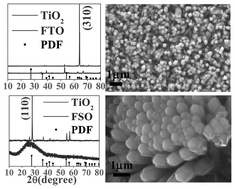The fabrication of one-dimensional (1D) rods or wires of titania in desired crystalline facets is quite exciting due to unique optoelectronic properties. The single crystalline, oriented nanorods directly grown on transparent conducting oxide (TCO) substrates are finding a lot of interest in solar photovoltaics and several other optoelectronic devices due to enhanced electron transport and lower exciton recombination rates. However, the growth of desired crystalline facets of highly oriented, single crystalline nanorods on different substrates and understanding the interplay between the surface chemistry and growth mechanism still remain a non-trivial and challenging task. Here, for the first time, the kinetically controlled growth of the (310) facet of TiO2 nanorods on fluorine-doped tin oxide (FTO) coated glass substrate has been reported which is in contrast to the previously reported (002) faceted TiO2 nanorods. In addition to this, the growth of (110) facet TiO2 nanorods using amorphous fluorine doped silicon oxide (FSO) as a substrate is also demonstrated. In this paper, it is shown that two different faceted TiO2 nanorods can be synthesized following same synthetic condition by varying only the material properties of the substrate. To investigate the role of substrate chemistry on the morphology and single crystallinity of TiO2 nanorods, electron microscopy, XPS and contact angle measurements have been done. The results clearly indicate an important link between the surface chemistry and morphology of TiO2 nanorods. It can be assumed that there is a role of OH− and water groups which are responsible for the growth of plane (110) which has less surface energy. The observation of (310) facet is quite surprising and can be explained based on FTO crystallinity. It is possible to tune the diameter of the titania nanorods by further coating the FTO substrate with a thin gold layer due to increase in the hydrophilicity of the substrate. Finally, a light to electricity conversion efficiency of 2.5% could be achieved by using vertically grown titania nanorods on FTO as the photoanode in a dye sensitized solar cell (DSSC).

You have access to this article
 Please wait while we load your content...
Something went wrong. Try again?
Please wait while we load your content...
Something went wrong. Try again?


 Please wait while we load your content...
Please wait while we load your content...